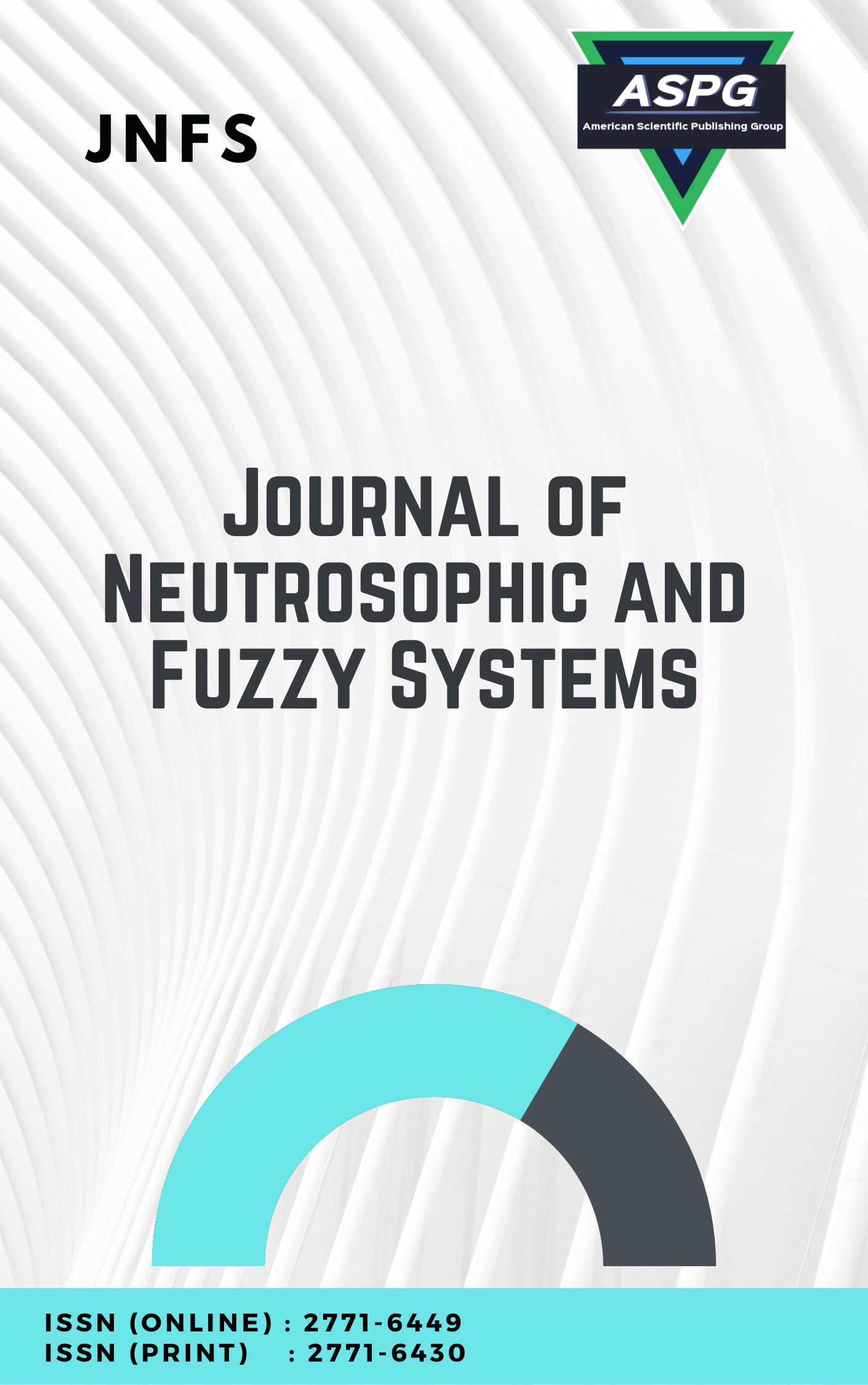

Volume 8 , Issue 1 , PP: 46-64, 2024 | Cite this article as | XML | Html | PDF | Full Length Article
Danyah Dham 1 * , Mohamed Bisher Zeina 2 , Riad K. Al-Hamido 3
Doi: https://doi.org/10.54216/JNFS.080106
In this study, we introduce Marshall-Olkin type II class of distributions within the neutrosophic and plithogenic framework. We provide the formal expressions for the probability density function and derive the cumulative distribution function. As a specific instance, we examine the generalization of the exponential distribution in both neutrosophic and plithogenic forms according to this new class, presenting the probability density function and deriving the cumulative distribution function for this case. Furthermore, we propose an algorithm for generating random numbers based on this distribution. Additionally, we estimate its parameters using maximum likelihood and validate the results through a simulation study, demonstrating the efficiency of the calculated parameters. We also investigate the asymptotic properties, including unbiasedness and consistency.
Marshall-Olkin Type II Class of Distributions , Neutrosophic , Plithogenic , AH Isometry , Maximum Likelihood Estimation , Random Numbers Generation.
[1] L. A. Zadeh, “Is there a need for fuzzy logic?,” Inf. Sci. (Ny)., vol. 178, no. 13, pp. 2751–2779, Jul. 2008, doi: 10.1016/J.INS.2008.02.012.
[2] G. Chen, Z. Liu, and J. Zhang, “Analysis of strategic customer behavior in fuzzy queueing systems,” J. Ind. Manag. Optim., vol. 16, no. 1, 2020, doi: 10.3934/jimo.2018157.
[3] L. A. Zadeh, “Fuzzy sets,” Inf. Control, vol. 8, no. 3, pp. 338–353, 1965, doi: 10.1016/S0019-9958(65)90241-X.
[4] K. T. Atanassov, “Intuitionistic fuzzy sets,” Fuzzy Sets Syst., vol. 20, no. 1, pp. 87–96, 1986, doi: 10.1016/S0165-0114(86)80034-3.
[5] M. L. PURI, D. A. RALESCU, and L. Zadeh, “Fuzzy Random Variables,” Readings Fuzzy Sets Intell. Syst., pp. 265–271, 1993, doi: 10.1016/B978-1-4832-1450-4.50029-8.
[6] M. Á. Gil, M. López-Díaz, and D. A. Ralescu, “Overview on the development of fuzzy random variables,” Fuzzy Sets Syst., vol. 157, no. 19, pp. 2546–2557, Oct. 2006, doi: 10.1016/J.FSS.2006.05.002.
[7] F. Smarandache, “Plithogenic Probability & Statistics are generalizations of MultiVariate Probability & Statistics,” Neutrosophic Sets Syst., vol. 43, 2021.
[8] R. A. K. Sherwani, S. Iqbal, S. Abbas, M. Aslam, and A. H. Al-Marshadi, “A New Neutrosophic Negative Binomial Distribution: Properties and Applications,” J. Math., vol. 2021, 2021, doi: 10.1155/2021/2788265.
[9] Z. Khan, M. Gulistan, N. Kausar, and C. Park, “Neutrosophic Rayleigh Model with Some Basic Characteristics and Engineering Applications,” IEEE Access, vol. 9, pp. 71277–71283, 2021, doi: 10.1109/ACCESS.2021.3078150.
[10] N. M. Taffach and A. Hatip, “A Review on Symbolic 2-Plithogenic Algebraic Structures,” Galoitica J. Math. Struct. Appl., vol. 5, no. 1, pp. 08–16, 2023, doi: 10.54216/GJMSA.050101.
[11] M. Abobala and M. B. Zeina, “A Study of Neutrosophic Real Analysis by Using the One-Dimensional Geometric AH-Isometry,” Galoitica J. Math. Struct. Appl., vol. 3, no. 1, pp. 18–24, 2023, doi: 10.54216/GJMSA.030103).
[12] M. B. Zeina and A. Hatip, “Neutrosophic Random Variables,” Neutrosophic Sets Syst., vol. 39, 2021, doi: 10.5281/zenodo.4444987.
[13] M. B. Zeina and M. Abobala, “A novel approach of neutrosophic continuous probability distributions using AH-isometry with applications in medicine,” Cogn. Intell. with Neutrosophic Stat. Bioinforma., pp. 267–286, Jan. 2023, doi: 10.1016/B978-0-323-99456-9.00014-3.
[14] A. Astambli, M. B. Zeina, and Y. Karmouta, “On Some Estimation Methods of Neutrosophic Continuous Probability Distributions Using One-Dimensional AH-Isometry,” Neutrosophic Sets Syst., vol. 53, 2023.
[15] S. Salem, Z. Khan, H. Ayed, A. Brahmia, and A. Amin, “The Neutrosophic Lognormal Model in Lifetime Data Analysis: Properties and Applications,” J. Funct. Spaces, vol. 2021, 2021, doi: 10.1155/2021/6337759.
[16] Z. Khan, A. Al-Bossly, M. M. A. Almazah, and F. S. Alduais, “On Statistical Development of Neutrosophic Gamma Distribution with Applications to Complex Data Analysis,” Complexity, vol. 2021, 2021, doi: 10.1155/2021/3701236.
[17] W. Q. Duan, Z. Khan, M. Gulistan, and A. Khurshid, “Neutrosophic Exponential Distribution: Modeling and Applications for Complex Data Analysis,” Complexity, vol. 2021, 2021, doi: 10.1155/2021/5970613.
[18] C. Granados and J. Sanabria, “On Independence Neutrosophic Random Variables,” Neutrosophic Sets Syst., vol. 47, 2021.
[19] M. B. Zeina, M. Abobala, A. Hatip, S. Broumi, and S. Jalal Mosa, “Algebraic Approach to Literal Neutrosophic Kumaraswamy Probability Distribution,” Neutrosophic Sets Syst., vol. 54, pp. 124–138, 2023.
[20] C. Granados, “New Notions On Neutrosophic Random Variables,” Neutrosophic Sets Syst., vol. 47, 2021.
[21] M. B. Zeina, M. T. Anan, and Y. Marjamak, “Random Numbers Generation and Goodness-of-Fit Testing for Literal Neutrosophic Numbers,” Galoitica J. Math. Struct. Appl., vol. 4, no. 2, pp. 08–23, 2023, doi: 10.54216/gjmsa.040201.
[22] M. B. Zeina, N. Altounji, M. Abobala, and Y. Karmouta, “Introduction to Symbolic 2-Plithogenic Probability Theory,” Galoitica J. Math. Struct. Appl., vol. 7, no. 1, 2023.
[23] D. Dham, M. B. Zeina, and R. K. Al-hamido, “Symbolic Neutrosophic and Plithogenic Marshall-Olkin Type I Class of Distributions,” Neutrosophic Sets Syst., vol. 59, pp. 234–252, 2023.
[24] N. Sets, N. Altounji, M. M. Ranneh, and M. B. Zeina, “Foundation of 2-Symbolic Plithogenic Maximum a Posteriori Estimation,” Neutrosophic Sets Syst., vol. 59, pp. 59–74, 2023.
[25] N. Sets, S. Massassati, M. B. Zeina, and Y. Karmouta, “Plithogenic and Neutrosophic Markov Chains : Modeling Uncertainty and Ambiguity in Stochastic Processes,” Neutrosophic Sets Syst., vol. 59, pp. 119–138, 2023.